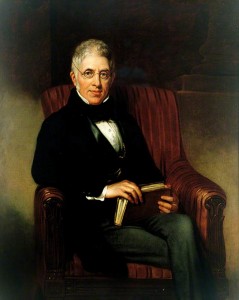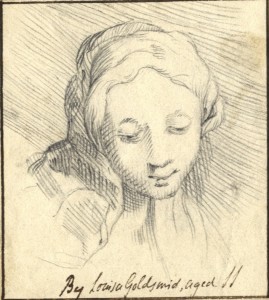Among Douce’s drawings in the Ashmolean there are many by amateurs like Francis Cohen (1788-1861). In 1823, Cohen changed his name to Palgrave and married one of Dawson Turner’s daughters, Elizabeth. Douce and Cohen became close friends and they met regularly in the 1810s and 1820s -the fourth son of the Palgraves, born in 1829, received the name of Reginald Francis Douce Palgrave. Cohen gave Douce this watercolour of a street in Brussels, painted during a trip to the Continent in 1815:
Another glimpse into Douce’s network of acquaintances is provided by the little, rather sweet, sketch below:
The young amateur to whom Douce’s annotation refers was probably Louisa Sophia Goldsmid (1819-1908), who would grow up to become the ‘feminist and promoter of women’s education’ Lady Goldsmid. Douce could have been given her drawing because it was made in the course of a visit to the Douces. The hatching in the face recalls that of a print, from which eleven-year-old Louisa would have copied it:
Douce might have met the future Lady Goldsmid through her uncle, the financier Sir Isaac Lyon Goldsmid (1778-1859), fellow of the Royal Society since 1828. As a member of this institution, Sir Isaac was likely to know both Palgrave and another of Douce’s closest and oldest friends, the writer Isaac D’Israeli:

Goodman, Sir Isaac Lyon Goldsmid, c. 1866, oil on canvas (c) UCL Art Museum; Supplied by The Public Catalogue Foundation
Sir Isaac, who became member of the Society of Antiquaries in 1830, was also a collector of coins, ivories, bronzes, and porcelains. In 1843, he was invited to the funeral of the bibliophile Duke of Sussex as one of his ‘personal friends’. Sir Isaac and Douce possibly met at the Duke’s apartments in Kensington Palace, where Douce was a regular visitor after an introduction by the physician Edward Fryer.



